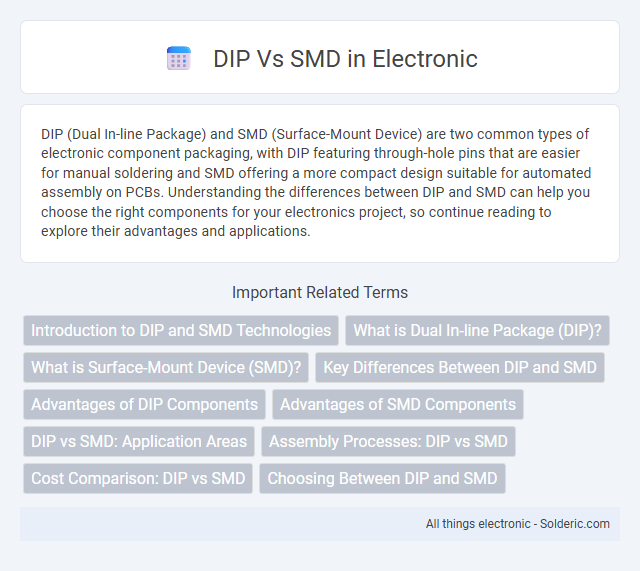DIP (Dual In-line Package) and SMD (Surface-Mount Device) are two common types of electronic component packaging, with DIP featuring through-hole pins that are easier for manual soldering and SMD offering a more compact design suitable for automated assembly on PCBs. Understanding the differences between DIP and SMD can help you choose the right components for your electronics project, so continue reading to explore their advantages and applications.
Comparison Table
| Feature | DIP (Dual In-line Package) | SMD (Surface-Mount Device) |
|---|---|---|
| Mounting Type | Through-hole | Surface mount |
| Size | Larger, bulky | Smaller, compact |
| Assembly | Manual or wave soldering | Automated pick-and-place |
| Performance | Stable mechanical connection | Improved high-frequency performance |
| Cost | Higher due to manual labor | Lower with automated assembly |
| Repair & Prototyping | Easier to handle and replace | More difficult to repair |
| Application | Prototyping, through-hole PCBs | Mass production, high density PCBs |
Introduction to DIP and SMD Technologies
Dual In-line Package (DIP) and Surface-Mount Device (SMD) represent two fundamental electronic component packaging technologies. DIP components feature through-hole leads suited for manual insertion and prototyping, while SMD components are designed for automated surface mounting on printed circuit boards (PCBs), enabling higher component density and improved electrical performance. The evolution from DIP to SMD has significantly enhanced manufacturing efficiency and miniaturization in modern electronics.
What is Dual In-line Package (DIP)?
Dual In-line Package (DIP) is a widely used packaging format for electronic components featuring two parallel rows of pins extending perpendicularly from a rectangular housing, allowing easy insertion into through-hole printed circuit boards (PCBs). DIP components are favored for prototyping and manual assembly due to their straightforward soldering and robust mechanical stability. Understanding DIP's pin configuration helps you optimize circuit design and troubleshoot connections efficiently.
What is Surface-Mount Device (SMD)?
Surface-Mount Device (SMD) refers to electronic components designed for direct mounting onto the surface of printed circuit boards (PCBs) without the need for through-hole leads. SMDs are smaller, allowing higher component density and improved performance in compact electronic devices. This technology facilitates automated assembly processes, enhancing manufacturing efficiency and reliability in modern electronics production.
Key Differences Between DIP and SMD
DIP (Dual In-line Package) components feature through-hole leads that are inserted into holes on a printed circuit board (PCB), while SMD (Surface-Mount Device) components are mounted directly onto the surface of the PCB without leads. DIP components are larger, allowing easier manual soldering and prototyping, whereas SMD components offer higher density, smaller size, and better performance for automated manufacturing. Understanding these key differences helps you choose the appropriate component type based on your design requirements and production scale.
Advantages of DIP Components
DIP (Dual Inline Package) components offer advantages such as easy manual handling and straightforward soldering, making them ideal for prototyping and repair tasks. Their through-hole design provides strong mechanical stability on circuit boards, which is beneficial in high-stress or vibration-prone environments. You benefit from clearer visibility and accessibility of pins, simplifying troubleshooting and modifications during development or maintenance.
Advantages of SMD Components
SMD components offer significant advantages including smaller size, allowing for higher circuit density and more compact device designs. Their automated assembly reduces manufacturing time and cost, ensuring greater consistency and reliability in production. You benefit from improved electrical performance and enhanced heat dissipation, making SMD ideal for modern electronics demanding efficiency and miniaturization.
DIP vs SMD: Application Areas
DIP (Dual In-line Package) components are commonly used in prototyping, through-hole mounting, and low-frequency applications due to their ease of manual assembly and testing. SMD (Surface-Mount Device) components dominate in high-density, high-frequency, and automated manufacturing environments, offering miniaturization and improved electrical performance. Your choice between DIP and SMD impacts design complexity, manufacturing processes, and performance optimization based on the specific application area.
Assembly Processes: DIP vs SMD
DIP (Dual In-line Package) components require manual insertion into through-hole PCB pads and are typically soldered using wave soldering or manual soldering processes, which can be time-consuming and less suitable for high-volume production. SMD (Surface-Mount Device) components are placed directly onto the surface of PCBs using automated pick-and-place machines, followed by reflow soldering, enabling faster, more precise, and cost-effective assembly. Choosing between DIP and SMD assembly processes impacts your manufacturing speed, efficiency, and the complexity of circuit design.
Cost Comparison: DIP vs SMD
DIP (Dual In-line Package) components generally incur higher manufacturing and assembly costs compared to SMD (Surface-Mount Device) due to larger material usage and manual soldering requirements. SMD technology reduces expenses with automated placement and smaller footprint, enabling denser circuit designs and lower PCB costs. Cost efficiency in SMD is evident in mass production, while DIP remains economical for prototyping and low-volume runs.
Choosing Between DIP and SMD
Choosing between DIP (Dual In-line Package) and SMD (Surface-Mount Device) depends on the application requirements such as ease of manual assembly and board space constraints. DIP components are larger, easier to handle for prototyping or repair, making them ideal for educational or hobby projects. SMDs offer higher component density and better performance in automated assembly, essential for compact and high-speed electronic devices.
DIP vs SMD Infographic

 solderic.com
solderic.com